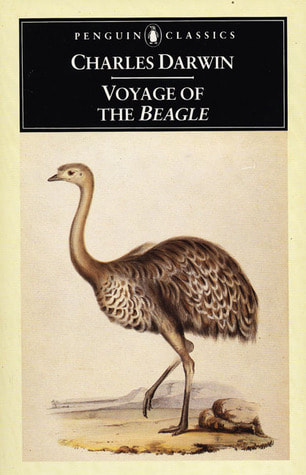|
Journey on the H.M.S. Beagle
By Charles Darwin Published in 1890 496 Pages Thibault’s Score: 4/5 This book should be taught in school. This is an amazing autobiographical book written by Charles Darwin where he describes his time as the naturalist on the H.M.S. Beagle, and explains how he discovered evolution. Recently, I read Charles Darwin’s autobiography which included every part of his life except his time on the H.M.S. Beagle, so I decided to read Journey on the H.M.S. Beagle. In 1831, Darwin left with the H.M.S. Beagle from England as a naturalist. He would spend the next 5 years exploring the Pacific and studying geology, anthropology, and biology. Part of the book was copied directly from notes Darwin took on the journey, and the rest was written in two waves in 1839 and 1845. Darwin has many great adventures. He journeys with General Juan Manuel de Rosas, the dictator of a small region in Argentina. He fights indians and animals. He crosses the Argentine desert without water. This book contains many interesting accounts of life in 19th century South America. Darwin was shocked to find out how primitive many of the locals are. In the third chapter, he describes the astonishment of indigenous natives when he showed them his compass. He also fascinated natives with his matches, and taught them how to use technology to easily start fires. Darwin took great pleasure in exposing the natives to advanced British technology and teaching them about the modern world. Darwin is also a deeply moral person. In the second chapter, he makes numerous anti-slavery arguments. He decries the sale of a slave family’s children, and is relieved when the owner decides not to split up the family. Later in the chapter, he is yelling at one of his black servants who had failed to follow his instructions. In doing so, he waves his hands, and the slave immediately lowers his own hands. Darwin realizes that the slave was worried that he would accidentally shield himself from Darwin, and be punished for thus resisting. After that incident, Darwin felt ashamed, and became a staunch moral opponent of the unfair treatment of blacks. From a biology perspective the insights are legion. For the first few chapters of the book, Darwin describes and compares many different exotic species of animals and insects, and he begins to ponder why species that are very similar can inhabit very different parts of the earth. I didn’t know that Darwin also was a paleontologist and found numerous dinosaurs in Argentina, findings which influenced his understanding of the theory of evolution. Interestingly enough, the animal Darwin writes the most about is probably the Ostrich. As the book progresses, Darwin writes more and more in evolutionary terms. He talks about the relationship between species, and talks about analogous species and related ancestry. By Chapter 17 where he recounts his stay on the Galapagos Archipelago, he talks blatantly about rats arriving on European ships and evolving to adapt to local conditions, and has already formulated the theory of evolution. As usual, Darwin doesn’t disappoint. His style of writing is complex but clear, and all of his thoughts are, as usual, very lucid. This is probably one of the best books to learn basic biology. The book reads like a 19th century adventure novel, and Darwin is constantly faced with interested situations. He also explains his reasoning and ideas to laypeople without a background in science very well. I strongly recommend Journey on the H.M.S. Beagle to anyone who is interested in biology and anthropology.
0 Comments
Leave a Reply. |
Thibault SerletMost of my articles are book reviews, but I also write about many other topics. Archives
December 2023
Categories |

 RSS Feed
RSS Feed